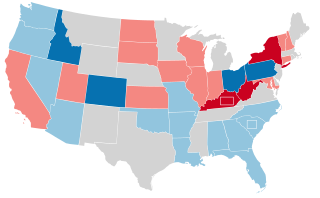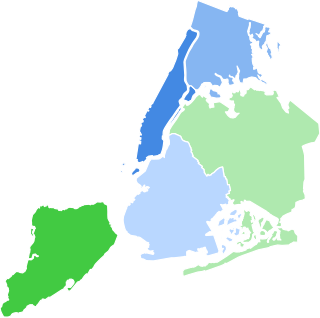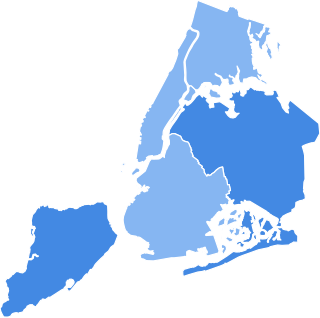
Tammany Hall, also known as the Society of St. Tammany, the Sons of St. Tammany, or the Columbian Order, was an American political organization founded in 1786 and incorporated on May 12, 1789, as the Tammany Society. It became the main local political machine of the Democratic Party and played a major role in controlling New York City and New York State politics. It helped immigrants, most notably the Irish, rise in American politics from the 1850s into the 1960s. Tammany usually controlled Democratic nominations and political patronage in Manhattan for over 100 years following the mayoral victory of Fernando Wood in 1854, and used its patronage resources to build a loyal, well-rewarded core of district and precinct leaders; after 1850, the vast majority were Irish Catholics due to mass immigration from Ireland during and after the Irish Famine of the late 1840s.
The Liberal Party of New York is a political party in New York. Its platform supports a standard set of socially liberal policies, including abortion rights, increased spending on education, and universal health care.

The 2005 New York City mayoral election occurred on Tuesday, November 8, 2005, with incumbent Republican mayor Michael Bloomberg soundly defeating former Bronx borough president Fernando Ferrer, the Democratic nominee. Several third-party candidates also ran for mayor. Bloomberg won four of the five boroughs, the exception being the Bronx.

The mayor of New York City is elected in early November every four years, in the year immediately following a United States presidential election year, and takes office at the beginning of the following year. The city, which elects the mayor as its chief executive, consists of the five boroughs, which consolidated to form "Greater" New York on January 1, 1898.

The 1956 United States Senate elections were elections for the United States Senate that coincided with the re-election of President Dwight D. Eisenhower. The 32 seats of Class 3 were contested in regular elections, and three special elections were held to fill vacancies. Although Democrats gained two seats in regular elections, the Republicans gained two seats in special elections, leaving the party balance of the chamber unchanged.

The 1944 United States Senate elections coincided with the re-election of Franklin D. Roosevelt to his fourth term as president. The 32 seats of Class 3 were contested in regular elections, and three special elections were held to fill vacancies.

The 1938 United States Senate elections occurred in the middle of Franklin D. Roosevelt's second term. The 32 seats of Class 3 were contested in regular elections, and special elections were held to fill vacancies. The Republicans gained eight seats from the Democrats, though this occurred after multiple Democratic gains since the 1932 election, leading to the Democrats retaining a commanding lead over the Republicans with more than two-thirds of the legislative chamber.

Frank Smithwick Hogan was an American lawyer and politician from New York. He served as New York County District Attorney for more than 30 years, during which he achieved a reputation for professionalism and integrity.
James Joseph Hines was a Democratic Party politician and one of the most powerful leaders of Tammany Hall in New York City.

The 1958 New York state election was held on November 4, 1958, to elect the governor, the lieutenant governor, the state comptroller, the attorney general, a judge of the New York Court of Appeals and a U.S. Senator, as well as all members of the New York State Assembly and the New York State Senate.

The 1938 New York state election was held on November 8, 1938, to elect the governor, the lieutenant governor, the state comptroller, the attorney general, two U.S. Senators and two U.S. Representatives-at-large, as well as all members of the New York State Assembly and the New York State Senate. The 1938 election was the first election where the Governor of New York was elected to a four-year term, rather than a two-year term.

The New York City mayoral election of 1977 occurred on Tuesday, November 8, 1977.

The 1952 United States Senate election in New York was held on November 4. Incumbent Republican Senator Irving M. Ives was re-elected to a second term in office over Democrat John Cashmore with a then-record margin of victory.

The United States Senate election of 1956 in New York was held on November 6, 1956. Incumbent Senator Herbert H. Lehman retired after one term in the Senate. Republican Attorney General of New York Jacob K. Javits defeated Mayor of New York City Robert F. Wagner Jr. to win the open seat.

The 1965 New York City mayoral election occurred on Tuesday, November 2, 1965, with Republican Congressman John Lindsay winning a close plurality victory over the Democratic candidate, New York City Comptroller Abraham Beame.

The New York City mayoral election of 1961 occurred on Tuesday, November 7, 1961. Incumbent Democratic Mayor Robert F. Wagner, Jr. won a decisive re-election victory for a third term in office. Wagner defeated the Republican nominee, state Attorney General Louis J. Lefkowitz, and the Citizens Party nominee, New York City Comptroller Lawrence E. Gerosa. Wagner received 51.03% of the vote to Lefkowitz's 34.46%, a Democratic victory margin of 16.57%.

The New York City mayoral election of 1953 occurred on Tuesday, November 3, 1953, with the Democratic candidate, Manhattan Borough President Robert F. Wagner, Jr. winning a decisive plurality in a three-way race.

The 1945 New York City mayoral election took place on November 6, 1945 in New York City. The candidates were King County District Attorney William O'Dwyer, a Democrat, and Jonah J. Goldstein, a Republican judge, as well as other, third party candidates.

The 1929 New York City mayoral election was held on November 5 in concert with other municipal elections. Democratic incumbent Jimmy Walker defeated Republican challenger Fiorello H. La Guardia in what was considered "a Crushing Defeat to [the] City G.O.P. [delivered]" by Tammany Hall. Socialist candidate Norman Thomas also ran, as did Socialist Labor candidate Olive M. Johnson and former Police Commissioner Richard Edward Enright for the Square Deal Party.
Robert Keaton Christenberry was an American businessman and political figure who served as president of the Hotel Astor, chairman of the New York State Athletic Commission and Postmaster of New York City and was the Republican nominee in the 1957 New York City mayoral election.




















